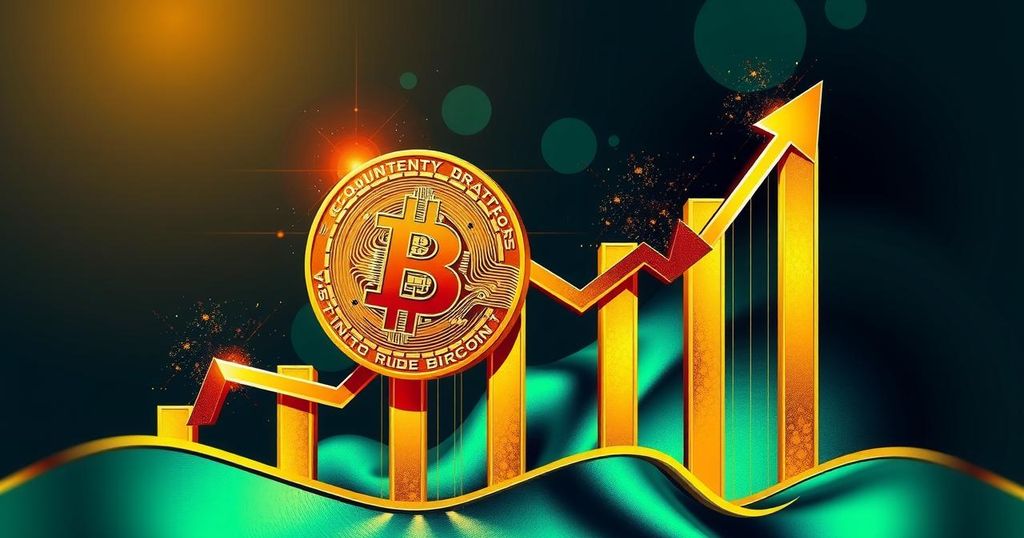Bitcoin Surges Past $87,000: Key Factors Behind the 2025 Crypto Rally
Bitcoin’s price has exceeded $87,000, aided by factors like macroeconomic uncertainty, a weakening U.S. dollar, and institutional investment. Key drivers include significant ETF inflows, a bullish technical pattern, and the potential establishment of a U.S. Strategic Bitcoin Reserve. Analysts see $90,000 as the next target, with caution advised due to potential economic shifts.
Bitcoin has seen a notable surge, surpassing $87,000 early Monday, continuing its recent rally, driven by various global economic conditions. Analysts attribute this increase to uncertainty in macroeconomic factors, a declining U.S. dollar, and a resurgence in institutional investment into cryptocurrencies. Having risen over 7% in just 48 hours, this spike signals a recovery from a dip below $82,000 and sets the stage for potential all-time highs by 2025.
Several key factors appear to be propelling Bitcoin’s ascent:
– Weakening U.S. Dollar: A notable drop in the U.S. dollar index followed President Trump’s harsh critique of the Federal Reserve. These concerns regarding monetary policy stability have pushed investors towards assets like Bitcoin and gold as inflation hedges, while the Japanese yen reached a seven-month peak against the dollar.
– Institutional Inflows and ETF Interest: An impressive $230 million in net inflows was observed in Bitcoin spot ETFs last week, according to Ark Invest and BlackRock. Furthermore, Metaplanet, a Japanese investment firm, acquired 330 additional Bitcoin, increasing its total holdings to nearly 5,000. This institutional interest is believed to provide market stability.
– Technical Breakout: Bitcoin’s price has successfully navigated through a long-standing resistance level between $85,000 and $86,300. The formation of a “golden cross” on the daily price chart, signifying a bullish trend, further supports this upward movement and is historically promising for investors.
– Bitcoin as a Strategic Asset: The Trump administration has initiated discussions about establishing a U.S. Strategic Bitcoin Reserve. This proposal aims to integrate Bitcoin into broader economic security strategies, heralding a significant step towards mainstream adoption from the perspective of crypto advocates.
Looking ahead, analysts are now targeting the psychological threshold of $90,000 as a crucial short-term goal. A successful breach of this level could energise bullish sentiment, potentially driving prices towards $92,000 or more. However, caution is warranted, as shifts in macroeconomic conditions, particularly inflationary pressures or decisive actions by the Federal Reserve, might dampen Bitcoin’s upward trend.
As articulated by Ava Greene from Argo Capital, Bitcoin is behaving like a macro asset again, responding dynamically to the weakening dollar, ETF inflows, and geopolitical uncertainties, which enhances its appeal to a broader spectrum of investors.
Current Bitcoin metrics (as of 10:45 a.m. ET) are as follows:
– Price: $87,104
– 24h Change: +3.26%
– Market Cap: $1.71 trillion
– Dominance: 54.6%
– Volume (24h): $41.3 billion
Given ongoing inflation worries and the approach of the 2025 tax season, this Bitcoin rally has stirred interest among American investors, leading to questions about its investment potential. Financial advisors remain cautious yet acknowledge Bitcoin’s robustness in long-term portfolios, urging investors to understand their risk profile and maintain prudent position sizes.
Marcus Patel, a wealth advisor based in New York, emphasises that while Bitcoin has demonstrated its value, understanding associated risks is critical for investors.




Post Comment